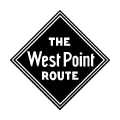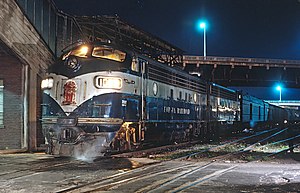
The Seaboard Coast Line Railroad was a Class I railroad company operating in the Southeastern United States beginning in 1967. Its passenger operations were taken over by Amtrak in 1971. Eventually, the railroad was merged with its affiliate lines to create the Seaboard System in 1983.

The Seaboard Air Line Railroad, which styled itself as "The Route of Courteous Service", was an American railroad that existed from April 14, 1900, until July 1, 1967, when it merged with the Atlantic Coast Line Railroad, its longtime rival, to form the Seaboard Coast Line Railroad. Predecessor railroads dated from the 1830s and reorganized extensively to rebuild after the American Civil War. The company was headquartered in Norfolk, Virginia, until 1958, when its main offices were relocated to Richmond, Virginia. The Seaboard Air Line Railway Building in Norfolk's historic Freemason District still stands and has been converted into apartments.

The Atlantic Coast Line Railroad was a United States Class I railroad formed in 1900, though predecessor railroads had used the ACL brand since 1871. In 1967, it merged with long-time rival Seaboard Air Line Railroad to form the Seaboard Coast Line Railroad. Much of the original ACL network has been part of CSX Transportation since 1986.

The Atlanta and West Point Rail Road was a railroad in the U.S. state of Georgia, forming the east portion of the Atlanta-Selma West Point Route. The company was chartered in 1847 as the Atlanta and LaGrange Rail Road and renamed in 1857; construction of the 5 ft gauge line was begun in 1849-50 and completed in May 1854. A large minority interest owned by the Georgia Railroad and Banking Company eventually passed under the control of the Atlantic Coast Line Railroad (ACL), which later acquired a majority of the stock.
The Atlanta and Birmingham Air Line Railway (A&BAL) was a railroad line running from Atlanta, Georgia to Birmingham, Alabama. It eventually ccame under the ownership of the Seaboard Air Line Railroad.
The Brunswick and Western Railroad is a historic railroad in southern Georgia that at its greatest extent ran from Brunswick near the coast to Albany. Segments of the line still exist today. The Brunswick and Florida Railroad ran from Brunswick west to Glenmore, where it would connect with the Atlantic and Gulf Railroad.
The Charleston and Western Carolina Railway (C&WC) was formed in 1896 to operate the lines of the former Port Royal and Augusta Railway (PR&A) and the Port Royal and Western Carolina Railway (PR&WC). The PR&A and PR&WC had originally been part of the Central of Georgia Railroad but the South Carolina Legislature had forced the railroad to give up the subsidiary lines. The Atlantic Coast Line Railroad (ACL) took over the C&WC in 1897 but operated it as a subsidiary until 1959 when the ACL fully absorbed it. Much of the original system is still in use by ACL successor CSX Transportation.
The Georgia, Carolina and Northern Railway was a Southeastern railroad that began after Reconstruction and operated up until the start of the 20th century. It ran from Monroe, North Carolina to Atlanta, Georgia and later became part of the Seaboard Air Line Railroad.
The Florida Railroad was the first railroad to connect the east and west coasts of Florida, running from Fernandina to Cedar Key. The line later became part of the Seaboard Air Line Railroad, and, where still in use, is operated by CSX Transportation and the First Coast Railroad. The highway corridor of SR 24, US 301, and SR A1A/SR 200 closely parallels the former Florida Railroad.
The Florida Central and Western Railroad was a rail line built in the late 1800s that ran from Jacksonville west across North Central Florida and the part Florida Panhandle through Lake City and Tallahassee before coming to an end at Chattahoochee. The line was later part of the Seaboard Air Line Railroad network from 1903 to 1967, and was primarily their Tallahassee Subdivision. The full line is still in service today and is now part of the Florida Gulf and Atlantic Railroad.
The Jesup Subdivision is a railroad line owned and operated by CSX Transportation in Georgia. The line runs from Jesup, Georgia to Folkston, Georgia for a length of 72.7 miles. It notable passes through Waycross, Georgia, a major CSX freight terminal and CSX operates numerous freight trains over the line. The Jesup Subdivision was once a major route for the Atlantic Coast Line Railroad, one of CSX's predecessors.
The Manchester Subdivision is a railroad line currently operated by CSX Transportation in Central Georgia. Its northern terminus is in Peachtree City, where it continues south from the Atlanta Terminal Subdivision. From Peachtree City, it runs for 38.8 miles (62.4 km) south to Manchester, Georgia, where it connects with CSX's Lineville Subdivision and Fitzgerald Subdivision. It is a major north-south route for CSX in Georgia.
The Aberdeen Subdivision is a railroad line owned by CSX Transportation in North Carolina. The line runs along CSX's S Line from Raleigh, North Carolina, to Marston, North Carolina, for a total of 86.9 miles. At its north end it continues south from the Norlina Subdivision and at its south end it continues south as the Hamlet Terminal Subdivision.
The Augusta Subdivision is a railroad line owned by CSX Transportation in the U.S. states of Georgia and South Carolina. The line runs from CSX's A Line at Yemassee, South Carolina to Augusta, Georgia, for a total of 87.7 miles (141.1 km). At its north end it connects with Norfolk Southern Railway and CSX's McCormick Subdivision.
Augusta Union Station was a train depot in Augusta, Georgia at 525 8th Street, serving trains from its opening in 1903 to its closing in 1968. The Spanish Renaissance styled building was in central Augusta at Barrett Square, five blocks from the banks of the Savannah River.

The Atlantic Coast Line Railroad’s Main Line was the backbone of the Atlantic Coast Line Railroad's network in the southeastern United States. The main line ran from Richmond, Virginia to Port Tampa just southwest of Tampa, Florida, a distance of nearly 900 miles. Along its route it passed through Petersburg, Rocky Mount, Florence, Charleston, Savannah, Jacksonville, and Orlando. With the exception of a short 61-mile segment in Greater Orlando, the entire line is still owned by the Atlantic Coast Line's successor, CSX Transportation, and is still in service as their A Line.
The Seaboard Air Line Railroad’s Main Line was the backbone of the Seaboard Air Line Railroad's network in the southeastern United States. The main line ran from Richmond, Virginia to Tampa, Florida, a distance of over 800 miles. Along its route it passed through Petersburg, Raleigh, Columbia, Savannah, Jacksonville, and Ocala, Florida. While some segments of the line have been abandoned as of 2022, most of the line is still in service and is owned by the Seaboard Air Line's successor, CSX Transportation as their S Line.
The Pittsboro Railroad was a railroad that historically ran from Moncure, North Carolina to Pittsboro, North Carolina, a distance of about 10.5 miles. The line became part of the Seaboard Air Line Railroad and operated as the company's Pittsboro Subdivision.
The Seaboard Air Line Railroad's East Carolina Line was the unofficial name of their line running from Hamlet, North Carolina through eastern South Carolina to Savannah, Georgia. Officially designated on Seaboard employee timetables as the Andrews Subdivision from Hamlet to Andrews, South Carolina, and the Charleston Subdivision from Andrews south, the line was known as the East Carolina Line by Seaboard employees due to its location in eastern South Carolina. With connections to the Seaboard's main line at both ends, the East Carolina Line was frequently used as an alternative freight route for the company.
The Atlantic Coast Line Railroad's Florence—Robbins Line was one of the company's secondary main lines that ran from Florence, South Carolina to Robbins. It was built in the late 1800s and large parts of it were built by the Atlantic Coast Line's predecessor companies. Parts of the line are still in service.









